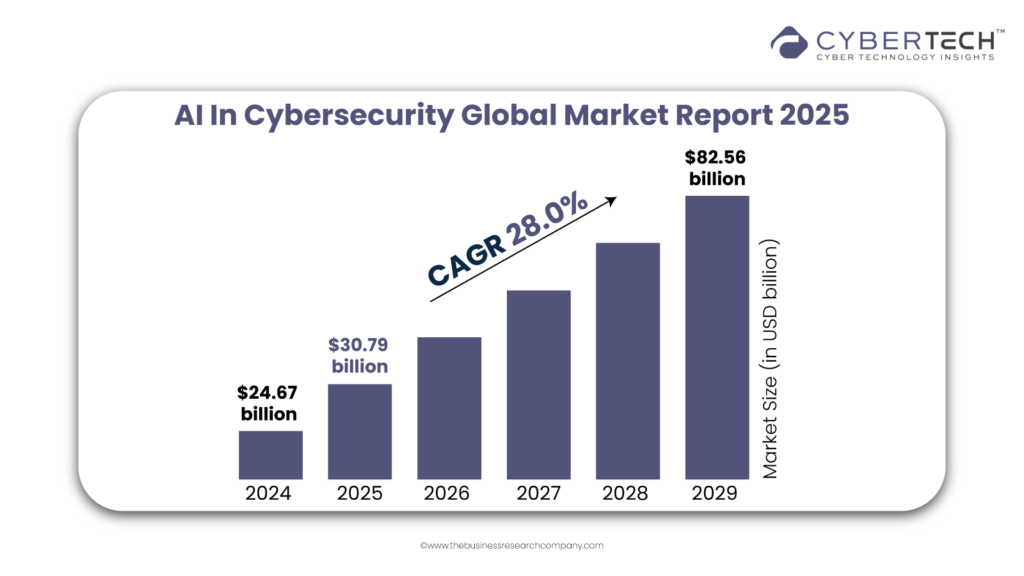AI Appreciation Day 2025 comes at a critical juncture in the evolution of AI in cybersecurity. The shortfall between defense capacity and live response has widened. As the velocity, volume, and variety of cyber threats become increasingly sophisticated. Industry-wide, organizations are confronting relentless ransomware operations, generative phishing campaigns, supply chain breaches, and increasingly AI-driven attackers.
But amidst these mounting threats, artificial intelligence has evolved not only as a shield but as an asset. The position of AI in cybersecurity has evolved from an exciting add-on to a mission-enabling layer. That too, within the security fabric of contemporary businesses. From identifying new threats to automating SOC processes and orchestrating anticipatory defense maneuvers, AI is now an integral force multiplier.
On this AI Appreciation Day, it’s significant to note how AI is revolutionizing cybersecurity management not theoretically, but practically. This post discusses the vital role of AI in cybersecurity in detection, response, governance, and also the resilience in 2025. Enabling CISOs and security leaders to rethink how they defend their organizations. This, too, is in an age where speed and accuracy can mean resilience or breach.

The Cyber Threat Environment of 2025 And Why AI in Cybersecurity Is Important
Cyber in 2025 is a new battlefield. Attackers no longer use brute force or social engineering alone. They are using AI to create polymorphic malware. Also, execute automated phishing campaigns that are virtually indistinguishable from humans, and even create deepfake-powered impersonation attacks at scale. The advent of offensive AI renders the classic reactive security paradigm inadequate.
Added to this, the cybersecurity market continues to grapple with talent deficiencies. Particularly in Security Operations Centers (SOCs), where analysts experience alert fatigue and time constraints to analyze threats thoroughly. Manual triage, redundant processes, and the inability to scale human intelligence in real-time have emerged as top pain points.
This is where AI in cybersecurity shifts from a nice-to-have to a must-have. AI capabilities, especially machine learning and natural language processing, are now essential. They detect patterns across millions of data points, automate repetitive tasks, and support decision-making for overwhelmed teams.
AI not only improves cybersecurity, it transforms it. With milliseconds mattering in today’s threat landscape, AI enables teams to shift from detection to containment. At fast, confident speeds, offering the level and depth of analysis necessary to stay ahead of today’s advanced attackers.
How AI in Cybersecurity Is Empowering Threat Detection and Prevention
AI-Powered Threat Intelligence and Early Detection
One of the biggest impacts of AI in cybersecurity is its ability to identify threats before they realize themselves as actual incidents. Based on Eftsure, 51% of organizations depend mostly on AI for threat discovery, leading prediction, and reaction. So, they learn to adjust to anomalies that diverge from normal baselines. This allows them to detect zero-day exploits, APTs, and insider abnormality early.
For instance, machine learning algorithms can consume and correlate large volumes of telemetry from firewalls, endpoint agents, cloud logs, and identity providers to detect subtle signs of compromise. They run in real time, identifying threats based on behavioral anomalies as opposed to coded logic, slashing time-to-detection by orders of magnitude.
Natural language processing (NLP) has an equivalent function in cyber threat intelligence (CTI). AI systems can analyze threat feeds, dark web activity, and unstructured intelligence reports to find new threat trends or targeted campaigns that often appear days or weeks ahead of manual analysis.
By combining AI with threat intelligence processes, security teams are empowered with the ability to foresee, equipping them with predictive power that tilts the scales from reactive defense to anticipatory defense.
AI in Endpoint and Network Protection
The cybersecurity endpoint and network frontline are getting stronger with AI-powered protection schemes. In 2025, extended detection and response (XDR) and endpoint detection and response (EDR) platforms are highly infused with AI that not only logs events but also understands them in real time. Zerothreat.ai says that AI-based endpoint security truncates attacks by 72%.
AI-based models now track everything from CPU usage peaks to unauthorized process runs, detecting suspicious activities at lightning speed even when malware is hidden or fileless. These tools can differentiate between legitimate user activity and threat actors trying lateral movement, credential escalation, or privilege misuse.
In networks, AI constantly scrutinizes east-west traffic. Also, port activity and encrypted sessions to detect anomalies that could be missed by human analysts. They train on terabytes of historical data as well as threat intelligence. So they can detect early-stage intrusions and stop data exfiltration before it can start.
For hybrid environment-managing organizations, the contribution of AI in cybersecurity goes even further. Providing security for distributed workloads, remote endpoints, and multi-cloud networks. Real-time detection automation on this scale would be impossible without AI at the center.
AI in Cybersecurity Operations is Revolutionizing the Contemporary SOC
Automated Triage and Alert Correlation
Security Operations Centers (SOCs) are the command centers of enterprise security, but legacy SOCs have long suffered from high volumes of false positives, data silos, and manual triage. In 2025, AI is driving the next-generation SOC, one that’s faster, smarter, and more self-driving.
AI systems consume telemetry from a variety of sources, endpoints, networks, cloud resources, identity platforms, and correlate threats with threat intelligence feeds in real-time. Instead of addressing each event separately, AI models cluster similar events into consolidated threat incidents, minimizing alert numbers and prioritizing the highest potential impact ones.
This transformation enables security analysts to spend less time filtering noise and more time analyzing threats that count. Machine learning algorithms retrain themselves constantly from verified incidents, getting better and better at detection and correlation over time to build a SOC that learns and adapts with each attack attempt.
AI-Driven Incident Response and Containment
In addition to detection, AI within cybersecurity now automates the way organizations respond to and contain threats. Upon breach detection, AI solutions will automatically run predetermined playbooks, quarantining impacted endpoints, locking down compromised accounts, and starting forensic data capture.
Advanced deployments use reinforcement learning, where responses are adjusted through feedback loops from past events. Such AI agents can evaluate the circumstances surrounding an incident, for instance, whether lateral movement is happening, and choose the optimum remediation route with minimal human intervention.
Natural language generation (NLG) features also assist incident response through automated generation of comprehensive reports for compliance, legal, and executive audiences. Automated summaries enhance accuracy, shorten recovery timelines, and alleviate communication bottlenecks for mission-critical incidents.
Case Example: An AI-Augmented SOC in Action
One top financial services company had a 65% decrease in mean-time-to-detect (MTTD) and a 70% decrease in false positives when it rolled out AI across its SOC. By using AI in cybersecurity functions such as automated triage, response orchestration, and case summarization, the company not only increased efficiency but also enhanced analyst morale and decreased burnout.
AI in Cybersecurity Risk Management and Governance
Cyber Risk Quantification and Predictive Analysis
In boardrooms from all sectors, there is one nagging question: How safe are we, and how much is it going to cost us? Cyber risk quantification was best-guessing up to now. But now with AI-powered cybersecurity, real-time data-driven cyber risk modeling produces definitive answers.
AI models weigh historical events, vulnerability insights, business asset priority, and adversary behavior to determine the probability and probable magnitude of breaches. These findings inform CISO and CIO dashboards that guide risk mitigation efforts, budget allocation, and executive reporting with precision.
Predictive analytics models also model future attack patterns, helping users know which vulnerabilities attackers are most likely to target and who they are. This enables proactive patching and resource allocation, based on actual threats instead of compliance checklists.
AI for Policy Automation and Compliance Monitoring
Compliance in 2025 is a steady, dynamic process and not an event that happens every quarter. AI in cybersecurity is increasingly applied to track policy enforcement and identify loopholes in real-time. It’s software scans infrastructure configs, access logs, and data flows to verify compliance with standards such as NIST, ISO 27001, GDPR, and CCPA.
AI automatically maps security controls to regulatory frameworks, minimizing manual labor needed for audits. Upon detection of deviations, automated alerts and remediation recommendations are sent instantaneously, maintaining compliance in real time and minimizing the likelihood of regulatory fines.
AI in Proactive Cyber Defense and Threat Hunting
Autonomous Threat Hunting and Attack Surface Monitoring
Cyber defense has historically been a reactive discipline, but that’s changing with AI in cybersecurity. With AI, organizations are moving left, proactive hunting for threats before they can attack. AI-driven systems continuously monitor internal and external environments for indicators of compromise (IOCs), unknown threats, and misconfigurations that attackers can use.
Autonomous threat hunting technologies run 24/7, searching through petabytes of information, detecting anomalies that traditional signature-based detection misses. These AI agents learn continuously from emerging attack methods and update detection rules automatically, much faster than human security teams ever can.
Deception Technologies and Adaptive Defense
AI is also driving deception technologies. Honeypots, once a static lure, are now AI-based decoys that learn based on attacker tactics. When an attacker breaches a network, these smart traps can escalate privileges, emulate file systems, and bait adversaries into disclosing tactics, all while isolating the threat.
In addition, by examining attacker activity in the deception layer, AI applications can refresh threat knowledge and enhance the overall defense infrastructure. This forward-thinking collection of intelligence enables cyber chiefs to construct systems that look ahead to predict attacker moves, rather than merely respond to them.
The Future of AI in Cybersecurity Management
Looking forward to 2025 and beyond, it is evident that AI for cybersecurity will keep developing not as an isolated solution, but as the glue that binds all layers of the security infrastructure together.
From Augmentation to Autonomy
We’re already seeing signs of autonomous cybersecurity systems capable of detecting, analyzing, responding to, and recovering from threats without direct human intervention. These “self-healing” architectures, powered by AI, will be critical as attack surfaces expand across cloud, edge, and IoT environments.
Security leaders will increasingly move from monitoring dashboards to orchestrating AI models that continuously optimize their organization’s digital defenses.
Convergence of AI in Cybersecurity and Cyber Resilience
Soon, AI for cybersecurity will be at the center of enterprise-wide cyber resilience not only blocking attacks, but also ensuring business continuity through predictive analytics, automated failovers, and dynamic resource allocation.
AI will further enable cyber insurance modeling, aid legal teams during breach announcements, and facilitate narrative intelligence for crisis communications. The intersection of AI, GRC (governance, risk, and compliance), and security operations will be the contemporary security leadership playbook.
Collaborative AI Defense Ecosystems
The future of cybersecurity defense will be constructed around common intelligence and federated models of AI, wherein technology providers, organizations, and governments come together to discover and neutralize new threats almost in real-time. Secure AI sharing initiatives, model standardization, and networks of inter-organization defense are already underway.
For each CISO, security architect, and SOC analyst defining the digital perimeter of their firm, the message is clear. AI is not the future of cybersecurity. It is the present. And it is worth appreciating.
FAQs
1. What is AI in cybersecurity?
AI in cybersecurity pertains to employing artificial intelligence to identify, stop, and act against cyber threats autonomously.
2. How is AI contributing to cybersecurity in 2025?
In 2025, AI in cybersecurity assists organizations in halting attacks quicker, minimizing false alarms, and safeguarding massive digital systems better.
3. Can AI prevent zero-day attacks?
Yes, AI in cybersecurity is able to identify unknown threats by identifying anomalous behavior, even in the absence of known attack signatures.
4. Is AI replacing cybersecurity human jobs?
No, AI in cybersecurity aids human teams by taking care of repetitive work and allowing them to concentrate on actual threats.
5. What are the risks of applying AI in cybersecurity?
AI can err, be deceived by attackers, or be biased, and therefore has to be applied cautiously with human intervention.
To participate in upcoming interviews, please reach out to our CyberTech Media Room at sudipto@intentamplify.com.



